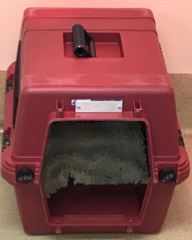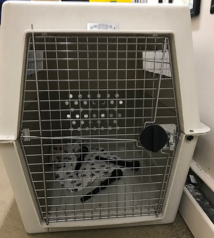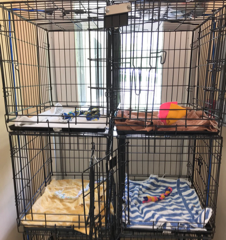Search for working dog conference recordings, articles on health, breeding, socialization and organizational management, webinar recordings and more.
Old Conference Archive Page | View all IWDC 2023 Recordings | View all Breeder's Workshop Colorado Recordings
-
Organization Management
-
Canine Resources
-
- Articles coming soon
-
-
- Emotional Conflict During Socialization
- What is environmental enrichment?
- Distance, Distraction and Duration
- Developing Foundational Skills
- Luring, Marking & Giving Food
- 5 Steps to Progressing Skills
- Dog-Human Relationship Skills
- Utilizing Volunteers
- Biosecurity
- Biosecurity protocol documents
- Example Socialization Schedule
- Puppy Socialization Tracker
- Crate Training
- Managing Inappropriate Interactions between littermates
- Preventing and Fixing Door Dashing
- Follow Me: Video
- Bath Progression: Video
- Intro to New Environments: Video
- Motor Development: Video
- Novel Objects: Video
- Novel Sounds: Video
- Trolley Ride: Video
- Wearing Things/Coat Desensitization: Video
- Carrying Puppies Safely
- Safely Using Stairs: Video
- Puppy Confidence Course
- Socialization Ideas Gallery
- Weighing Puppies: Video
- Birth of a Puppy: Video
- First Time Outside the Den: Video
- First time Exploring the Garden: Video
- Exploring the garden in the dark: Video
- Include puppies in the daily work routine: video
- Collar Habituation: video
- Exploring a wobble board
- Exploring the world - unfamiliar surroundings
- Walking around the grounds
- Socialization opportunities in daily life
- Walk in the woods
- Exploring the world
- Free time for moms
- Explore the stairs and garden
- Explore the puppy garden
- Show Remaining Articles ( 28 ) Collapse Articles
-
- Articles coming soon
-
Education
-
-
- A Behavioral Questionnaire for Selection and Study of Odor Detection Dogs - Presented by Cynthia Otto
- Audeamus PTSD Service Dogs, ACAC Accredited Peer-Support Model for Veterans and First Responders - Presented by Chris Lohnes and Grace Rath
- Audeamus Service Dogs and University of Saskatchewan Research Partnership and Outcomes - Presented by Chris Lohnes & Grace Rath
- Building a Purpose Bred Breeding Program - Presented by Allison Peltier and Rachel Goldammer
- Core body temperature and activity level changes during work and exercise in patrol dogs of the Queensland Police Service - Presented by Jayne McGhie
- Detection of Heterobasidion parviporum scent samples in indoors scent discrimination test by trained volunteer dog-handler teams - Presented by Heli Väätäjä
- Development of a Tool to Aid in the Selection and Pairing of Breeders based on Behavioral Traits - Presented by Jordan Smith
- Early Detection of Heat Stress in Working Dogs - Presented by Andrea L. Henderson
- Effects on behavior and physiology of handling style during veterinary visits - Presented by Karen Overall
- Field cooling for exertional hyperthermia - Presented by Cynthia Otto
- From Anxious to Resilient: The Role of Dynamic Interactive Engagement in Shaping Military Working Dogs - Presented by Melanie Uhde
- Genetic Resources to Improve Dog Health - Presented by Angela Hughes (Royal Canin)
- Genomic research in the Working Dog Field: Combating Canine Cancer through Collaboration and Comparative Oncology Research - Presented by Frances L. Chen
- Handler Perceived Risks to Operational Detection and Patrol Police Dogs - Presented by Jayne McGhie
- Improving Trauma Patient Care - Presented by Kelly Hall
- Neuromuscular Balance Training in Working Dogs - Presented by Andrea L. Henderson
- Occupational Risks and Specialized Veterinary Care for Working Dogs - Presented by Cynthia Otto
- Putting working dog research into practice: development of science-based guidance notes - Presented by Fiona Williams
- Rating of Perceived Exertion in Working Dogs - Presented by Andrea L. Henderson
- Real-world experience with liquid biopsy testing for cancer detection in working dogs - Presented by Jill Rafalko
- Specialty Practice Behavioral Problems and Outcomes in Companion Dogs - Implications for Working Canines - Presented by Walt Burghardt
- Start of life – Feeding during pregnancy and lactation to increase reproductive success - presented by Angela Hughes (Royal Canin)
- Teaching Collar Yielding as a Foundation Behavior - Presented by Patrick Glines
- The Doberman Diversity Project: a Citizen Science approach to breed improvement - Presented by Sophie Liu
- The effect of inhibitory control, arousal, and affective state in Military Working Dogs Performance - Presented by Astrid Concha
- The effect of training aid volume on odor generalization in detection of chronic wasting disease in deer - Presented by Mallikarjun and Wilson & Cindy Otto
- The Many Dogs Project: A Big Team Canine Science Effort - Presented by Sarah-Elizabeth Byosiere
- Transformative Power of Freedom of Choice in Changing Behavior - Presented by Marty G. Roache
- Turning a Critical Eye on an Established Breeding Program to Improve End Results Using IWDR - Presented by Natalie Ergler and Rachel Goldammer
- U.S. Military Working Dog Welfare - Presented by Desireé Broach
- What is the future of Biological Detection Canines? - Presented by Heather Junqueira & Ken Furton
- Working dog memory and canine gut microbiome - Presented by Xu Wang
- Show Remaining Articles ( 17 ) Collapse Articles
-
- Breeding Healthy Dogs - Presented by Madeline Zimmermann
- Choosing What to Breed For - Presented by Madeline Zimmermann
- Gaiting - with Doug & Colton Johnson
- Genetic Merit Selection - Presented by Madeline Zimmermann
- Improving Behavior - Presented by Jane Russenberger & Dr. David Roberts
- IWDR: Storing your Data - Presented by Rachel Goldammer
- Keep Data on Everything! - Presented by Rachel Goldammer
- Long-Term Colony Management: Balancing genetic improvement breeding for the whole dog - Presented by Dr. Eldin Leighton
- Power of Numbers: IWDR Functions - Presented by Rachel Goldammer
- Producing Puppies - Presented by Dr. Fiona Hollinshead and Dr. Greg Burns
- Puppy Socialization - Presented by Jane Russenberger
- Puppy Socialization for Handling - presented by Doug & Colton Johnson
- Reading Dog Behavior/Emotional States - Presented by Dr. Karen Overall
- Whelping and Neonatal Care - Presented by Dr. Fiona Hollinshead and Dr. Greg Burns
-
- "All about the boy" - Semen Collection and Analysis - presentation by Dr. Fiona Hollinshead
- All about the brood - presentation by Dr. Greg Burns
- Behavior Checklist (BCL) Workshop - with Helen West
- Behavioral scoring in Puppy Raising - presentation by Helen West
- Brood and Whelping Concerns - presentation by Dr Greg Burns
- Calculating Differential Risk of Osteoarthritis in Dogs with Low vs High Hip Scores - presentation by Dr Tom Lewis
- Cardiac diseases - presentation by Dr Kevin Conrad (absent); presented by Dr. Kyle Quigley
- Conditioning Program for Dogs Coming In For Training - presentation by Dr Kevin Conrad (via zoom)
- Critical periods of socialization and impact on temperament of the dog - presentation by Jane Russenberger
- Does early potty training affect indiscriminate relieving? - presentation by Dr Lynna Feng
- Dog behavior is in the eye of the beholder - presentation by Joke Monteny
- Entropion - presentation by Jenna Bullis
- Feeding for Breeding Success - presentation by Dr. Emmanuel Fontaine
- Gait and Structure Evaluation for Guide Dogs - presentation by Peggy Gibbon and Dr Katy Evans
- GDBart Puppy Test - presentation by Helen West
- Healthy microbiome and faecal transplants - presentation by Dr Kevin Conrad (absent); presented by Dr Caroline Moeser
- Hip and elbow assessments - with Dr Bart Broeckx
- How to make breeding decisions on traits without EBVs - presentation by Madeline Zimmermann
- How to use estimated breeding values successfully - presentation by Madeline Zimmermann
- Improving behavior with EBVs: Body sensitivity, Noise Fear, Inhibited by Stress, Activated by Stress, Excitable - presentation by Jane Russenberger
- Improving health using EBVs: Elbow, Skin and Mast cell tumours - presentation by Madeline Zimmermann
- Is it really epilepsy? - with Dr Bob Proesmans & Dr Caroline Moeser
- Neonatal Care - presentation by Dr Emmanuel Fontaine
- Reproductive Trends and Cryogenic Insights from Guiding Eyes - presentation by Clover Williams
- Selecting Reproductively Healthy Dogs - presentation by Dr Emmanuel Fontaine
- Skin allergies - with Dr Caroline Moeser
- Stargardt's disease in Labrador retrievers - with Dr Katy Evans
- Strategies for genetic diversity - presentation by Jackie Clark and Dr Bart Broeckx
- Superficial Digital Flexor Tendon Avulsion - presentation by Dr Caroline Moeser
- The art of insemination - presentation by Dr. Fiona Hollinshead
- The Overall Selection Index - presentation by Dr Eldin Leighton
- What influences semen quality? - presentation by Dr. Tom Lewis
- Show Remaining Articles ( 17 ) Collapse Articles
-
- A detailed evaluation of Spotted Lanternfly (Lycorma delicatula) detection dog training and performance - Presented by Edgar O. Aviles-Rosa
- A novel method for the detection of Japanese knotweed (Reynoutria japonica) using specially trained canines - Presented by Kat Janczur
- AKC Detection Dog Task Force Program: Working with AKC Breeders to Improve Breeding & Availability of Explosives Detection Dogs - Presented by S Goffe
- Assessing working dog fitness with the Penn Vet Working Dog Center Fit To Work program - Presented by Brian Farr
- Assessment of the Agreement between Fosters and Trainers Evaluating Behavior with the C-BARQ and Behavior Checklist presented by Elizabeth Hare
- Behaviour Assessment and IWDR - Presented by Dr Jane Russenberger
- Breeding Strategies and Advanced Reproductive Techniques to Optimize Production of Improved Generations of Specialized Canines at Three major working dog breeding programs in New Zealand - presented by Dr Fiona Hollinshead
- Development and heritability of cognitive traits in Canine Companions dogs presented by Emily Bray
- Digital innovation for working dogs - Presented by Dr Mia Cobb
- Discrimination between SARS-CoV-2 infection and other viral respiratory infections by working dogs - Presented by Nele ten Hagen
- Effect of impulsivity and core effect on training performance in dual purpose military working dogs - Presented by Astrid Concha
- Epilepsy in working dogs - Presented by Prof Holger Volk
- Estimated Breeding Values in IWDR - Presented by Dr Eldin Leighton
- Examining the Role of Significant Others in Canine Welfare within the Context of Veterans Working with Service Dogs - Presented by Linzi Williamson
- Explosive detection canine operational requirements and performance degradation: expert perspectives - Presented by Brian Farr
- Hot Topics in Working Dog Care - Presented by Dr B. Pierce & Dr K. Mann
- Implementation of a plan to decrease arousal and increase motivation - Presented by Robert Dougherty Jr and Alena Heyer
- Improving behavior monitoring within a working dog program - Presented by Becky Hunt
- Incidence of enteric pathogens versus presence of gastrointestinal symptoms in a working dog training facility - Presented by Dr Nicola Cotton
- Investigation of tail injury at Lackland Air Force Base Training Kennels for Military Working Dogs - Presented by Marty G. Roache & Karen L. Overall
- Learning to Smell: Impacts of Training and Experience on Detection Dog Performance - Presented by Nathaniel Hall
- Lecture on Generalization in Detection Work - Presented by Hans Ebbers
- Liquid biopsy screening for early cancer detection in working dogs - Presented by Katherine M. Lytle, DVM, MPH, MS
- Military Working Dog Aggression and Welfare - Presented by Desiree Broach
- Multimodal characterization of detection dog suitability: Combining behavioral, cognitive, and neurological measures for enhancing selection - Presented by Lucia Lazarowski
- Overview of the IWDR for Working Dog Organizations - Presented by Dr Eldin Leighton
- Pandemic or pandemonium? Creating standards for medical detection dogs - Presented by Dr Cynthia Otto
- Penn Vet Working Dog Center Fit To Work program foundational fitness development and training - Presented by Meghan Ramos
- Preliminary Accuracy of COVID-19 odor detection by canines - Presented by Kenneth G. Furton
- Prevalence of Canine Degenerative Myelopathy SOD-1 Mutation in Working Shepherd Dogs across Australia and New Zealand - Presented by Jayne McGhie
- Scent dog identification of SARS-CoV-2-infections- a double blind study - Presented by Esther Schalke
- Solving cold-cases: Dogs can match human scents collected several years apart - Presented by Margot Perez
- The Application / Practical Implementation Pro/Cons of Covid-19 Olfactory Detection Dogs - Presented by Prof D Grandjean
- The Domestic Breeding Consortium: Odor Detection Canine Selection, Breeding, and Early Training Techniques - Presented by Karen Meidenbauer
- The effect of maternal style on later puppy behavior in Canine Companions dogs - Presented by Brenda Kennedy
- The use of historical health records at The Seeing Eye in genome-wide association studies for canine health traits presented by Katy M. Evans
- Training with Varying Odor Concentrations: Implications for Odor Detection Thresholds in Canines - Presented by Mallory DeChant
- Transitioning a Therapy Dog Program Online: What's In It For the Dog? - Presented by Ben Carey
- Using IWDR's Advanced Tools to Improve HeaLth and Behaviour - Presented by Dr Eldin Leighton
- Using Single-Step Genomic BLUP to Compute Genomic Enhanced Breeding values for Self-Modulation in Working Dogs presented by Molly Riser
- Using trained dogs and organic semi-conducting sensors to identify asymptomatic and mild SARS-CoV-2 infections - Presented by Dr Claire Guest and Prof James Logan
- Working Dog Welfare: Where are we now and where are we going? - Presented by Dr Mia Cobb
- Show Remaining Articles ( 27 ) Collapse Articles
-
- A canine thermal model for mitigation of heat strain in working dogs - Presented by C. O'Brien
- Building a better detector dog: Lessons learned and (many) questions remaining to be explored in Auburn University’s 19 years of detector dog production - Presented by P. Waggoner, PhD
- From Puppyhood to Adolescence: Longitudinal Cognition Study at Canine Companions for Independence - Presented by K. Levy
- Genome-wide association studies to identify loci and variants associated with behavioral traits in dogs - Presented by V.D. Marinescu, PhD
- Hyper-reactivity in military working dogs: a report of two cases - Presented by O. Soares, DVM, PhD
- Measuring, and determining factors affecting performance of glycemic alert dogs - Presentation by N. Rooney, PhD
- Neuromotor development in puppies: implications for training and fitness - Presented by B. Pierce, DVM, MS, DACVIM, DACVP, DACVSMR
- Odour generalisation – theory and practice - Presented by A. Schoon, PhD
- Putting working dog research into practice: development of science-based guidance notes - Presented by V. Ratcliffe, PhD
- Referential focus - pet & working dogs - Presented by K. Overall, MA, VMD, PhD, DACVB
- Statistics for working dogs – how do you know if your test/assessments are better than a coin toss? - Presented by A. Dunham, PhD
- Temperament and EBV - Presented by Erling Strandberg, PhD, SKK
- Testing dogs for behaviour in Sweden: Canine temperament - assessment and heritability & How you assess temperament - presented by Åke Hedhammar DVM, PhD & Kenth Svartberg, PhD
- The chemistry of odor: How understanding odor can foster a better detector - Presented by L. De Greeff, PhD
- The opioid crisis and working dogs - Presented by C. Otto, DVM, PhD, DAVCECC
- What helps and what hinders assistance dog/puppy raising practices? - Presented by Doc Loc Mai (Jimmy)
- Working Dog Centre: Working hard for working dogs - Presented by W. Baltzer, DVM, PhD
- Show Remaining Articles ( 2 ) Collapse Articles
-
-
-
- Veterinary Genetics with Dr Angela Hughes
- Optimizing Volunteers for Early Socialization Success with Liz Rote
- Inbreeding in Working Dog Colonies with Dr Eldin Leighton
- Partners in crime - help puppy raisers turn fun policing upside down - with Matthias Lenz
- Improving Digital Processes and Datakeeping for Volunteers and Working Dog Programs - with Dani Prebensen
- Walk and Talks: Beyond the Data - with Jackie Clark
- Building a Healthy Relationship with Your Nonprofit Board - With Laura Edwards
- Identify and Build a Healthy Nonprofit Board – With Laura Edwards
-
-
-
Payment and Accounts
This training helps each pup accept being alone. As with all training crate acceptance is a progression. The handler will support each pup to help build their ability to remain calm in a crate. Ideally the handler can be disengaged and eventually the crate tower can be placed out of site.
As learning progresses through repetition, the pup associates the crate with a positive place to be highlighted with a food filled toy and getting out when quiet. At the end of the session, the door is opened when pup is quiet. DON’T PRAISE or make a big deal FOR LEAVING THE CRATE, the skill we are building is *loving your crate*.
Key Points:
- pup is happy, relaxed and accepts being alone and confined
- support lessens as pup demonstrates the ability to settle
- handler moves away only when pup is comfortable
- keep a watchful eye on pup and his body language.
- Pup’s movements should be slow, relaxed, quiet (ei: tail and breathing slow, sits on own, lays down).
- Watch for pup stress signals (ei: fast tail movements, rapidly pacing, climbing and or pawing crate, ears pin back, panting, whining, crying and or barking just to name a few).
- *If pup is showing signs of stress handler is progressing too rapidly; support the pup. Do not abandon a stressed pup, you are there to help pup learn to self-settle.
Giving support can look like:
- Move crate tower to a quiet space,
- speak quietly to pup,
- Touch pup through the crate,
- drop kibble when pup is quiet,
- place a plush toy in crate,
- place a hard toy in crate.
Suggested Age to Time Chart
| Age | Session | Paired or Solo | Duration | Crate Conditions |
| 3-6 weeks | When pups are in pen | All pups | 24/7 | Passive crating (no door) in 200 vari kennel. Fleece in bottom. Mom in pen but outside of crate. |
| 3-6 | During Cleaning | All pups | 60 min | Active crating (door closed) in 500 vari kennel. Fleece in bottom. Add stuffed milkers at 4 weeks. |
| 4 weeks, 2 days | 1 | Paired | 3min | In 500 vari kennel with stuffed milkers. Sprinkle kibble for struggling pups. |
| 4 weeks, 4 days | 2 | 5min | ||
| 4 weeks, 6 days | 3 | 5min | ||
| 5 weeks, 1 day | 4 | Paired | 5 min | Wire crates with suffed toy and towel on bottom. Stuffed milkers. Sprinkle kibble for struggling pups. |
| 5 weeks, 3 days | 5 | 10min | ||
| 5 weeks, 5 days | 6 | Solo | 10min | |
| 6 weeks | 7 | 15min | ||
| 7weeks | 8 | Solo | 20min | |
| 8 weeks | 30min |
*The times listed are suggested times only. It might vary from pup to pup and litter to litter.
Our goal is to expose puppies to the crate in a positive way!
Crate examples

200 vari kennel with fleece in bottom.

400-500 vari kennel with fleece in bottom.

Wire crate with towel and stuffed toy.
The 6 Stages of Crate Games
Depending on the age of the puppies in your facility, these crate games can be useful for older puppies as it reinforces many of the skills learned plus teaches self control. Puppy should be comfortable and already have positive associations with the crate, which these games can build on. Start with the first stage and progress at a level the puppies can manage – repeat stages as needed to reinforce the skill and enable puppy to succeed.
Stage 1
- Open the crate door and stand facing the open doorway with pup on short lead
- Wait for pup to go into crate of own accord (do not give pup any instruction or eye contact) NOTE: DO NOT TOUCH YOUR TREAT POUCH UNTIL PUP HAS GONE INTO THE CRATE
- As soon as pup goes in, pay with treat high (e.g. hold treat higher to encourage puppy to remain in a sit position) and at the back of the crate to inadvertently cue a sit behaviour
- Remove pups lead, close the door, and take a step away
Stage 2
Stage 2 follows immediately from stage 1 so pup is in crate without a lead
- Crouch down, open crate then treat high and at the back of the crate
- Close door and step away
- Repeat several times
NOTE: If at any time the pup moves out of a sit or down position, close the door and step away again. Wait a moment then try again.
Stage 3
Stage 3 follows immediately from stage 2 so pup is in crate without a lead:
- Crouch down, open crate and clip lead 3 times beside pup’s collar without connecting it (pup is learning not to get excited when it sees the lead in our hand)
- Treat high and at the back of the crate
- Close door and step away
- Repeat several times
NOTE: If at any time the pup moves out of a sit or down position, close the door and step away again. Wait a moment then try again.
Stage 4
Stage 4 follows immediately from stage 3 so pup is in crate without a lead
- Crouch down, open crate
- Attach lead to pups’ collar
- Treat high and at the back of the crate
- Detach lead from pup’s collar
- Close door and step away
- Repeat several times
NOTE: If at any time the pup moves out of a sit or down position, close the door and step away again. Wait a moment then try again.
Stage 5: The Gamble
Stage 5 follows immediately from stage 4 so pup is in crate without a lead
- Crouch down, open crate
- Attach lead to pups’ collar
- Stand back with pup on lead and door open
- Wait 1-3 seconds
- Mark and treat high and at the back of the crate
- Remove the lead
- Close crate door and move away
- Repeat several times
NOTE: If at any time the pup moves out of a sit or down position, close the door and step away again. Wait a moment then try again
Stage 6
Stage 6 follows immediately from stage 5 so pup is in crate without a lead
- Crouch down, open crate
- Attach lead to pups’ collar
- Treat high and at the back of the crate
- Stand back with pup on lead and door open
- Wait 1-3 seconds
- Present target hand outside the crate to encourage dog to leave crate
- When pup targets, mark but DO NOT TREAT (Value needs to be in entering and being in crate, not when exiting it)
- Immediately turn around and lure pup to stand back in front of open crate door
- Keep lead short and wait until pup goes into crate again (same as in stage 1)
- Mark and treat high and at the back of the crate
- Repeat several times gradually increasing length of wait before targeting pup out of crate
NOTE: If pup tries to exit before the target hand is presented, immediately close the door to crate, step away and try again in a few minutes.
